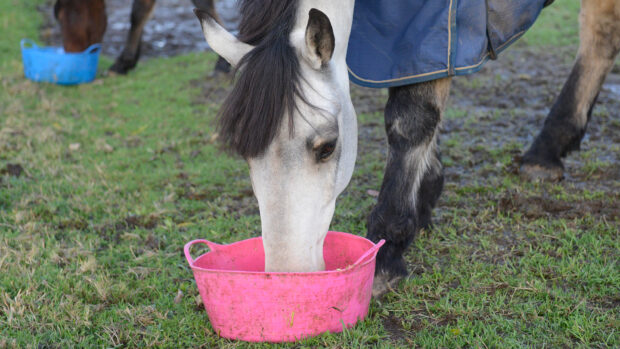The owners of hardworking competition horses might wonder what a balancer can do for their horses. Should they add one to the diet? The answer is, maybe. It depends on the horse, whether it’s a hard keeper or an easy keeper or sensitive to diet, and what else you’re feeding it. We speak to equine nutritionists, to find out more.
Lizzie Drury, senior nutritionist with Saracen, explains: “Feed balancers can be useful for competition horses, especially those that are training, travelling and competing on a frequent basis, as they can help to provide that extra layer of support to the immune system, digestive system and muscular system. If horses are already being fed the recommended levels of a competition feed, then a balancer can be top dressed on top of this feed at half of the recommended feeding rate e.g. 2.5kg of a competition feed and 250g of a balancer.
“They are also good for competition horses who have poor or fussy appetites when away from home to provide essential dietary elements to horses with limited appetites or reduced fibre intakes.”
Kate Hore, RNutr (Animal), registered nutritionist at NAF, further elaborates: “They allow you to feed the essential micronutrients in a very concentrated way, reducing or removing the need for starchy concentrate or ‘hard’ feed. Increasingly research recognises the negative effects of high cereal diets, whether that be on gastric ulcers, weight gain, laminitis, poor behaviour or other health issues. Feeding as nature intended — a high fibre, low cereal diet – allows your horse’s system to work naturally and efficiently, so your horse can work and compete in comfort, and concentrate on the job in hand.”
As with all feeds, owners have choices, and to get the most out of a balancer, they should work out which products suit their horse.
Clare Barfoot, RNutr, marketing, research, and development director at Spillers, says there are roughly two types of performance-orientated balancers: “A premium multi balancer should be rich in amino acids including lysine and methionine to support muscle development and topline. It will usually include antioxidants to support the immune system and probiotic live yeast and prebiotic MOS for digestive health.
“A performance balancer should be used to enhance a base performance diet while not oversupplying nutrients such as selenium and iron that will be already be present in the base diet. Ideally a performance balancer should include antioxidants and vitamins E and C to support muscle, immune and respiratory health and probiotic live yeast and prebiotic MOS and FOS to support digestive health.”
Which type you use depends on your feeding regime, and whether the horse is already getting enough selenium or iron, for example. And not all performance horses require a full ration of compound feed, which might reduce their intake of nutrients and amino acids. For those who do not, Clare says: “[Balancers] will ensure that their extra dietary needs are supported to best effect.”
For your horse to be at his best, he needs the correct amount of nutrients. Katie Grimwood, BSc (Hons), nutritional advisor at Bailey’s, stresses: “It is important that their vitamin and mineral requirements are being met through the provision of a fully balanced diet. It is a common misconception that feed manufacturers deliberately recommend feeding large quantities on the backs of bags of mixes or cubes, in order to sell more feed, but this is simply not the case. Manufacturers typically formulate mixes or cubes to be fed at certain levels, depending on the horse’s size and workload, and these levels will generally be the minimum amounts of feed required to provide a balanced diet alongside average quality forage.”
However, she continues: “Feeding the full recommended amounts according to the bag may provide the horse with too many calories (resulting in excess weight gain), but taking the mix or cube out completely would not be enough! If you are feeding less than recommended amounts, then a balancer can be really useful, to ‘top up’ the nutrients your horse may be lacking, but without too many calories.”
Similarly, if your horse gets too hot or fizzy on mixes or cubes, you might reduce those feeds. It might make him more rideable, but at the same, risks underperformance due to deficiencies in nutrients. The reason, Katie explains, is that: “Vitamins and minerals are important for all horses to support metabolism and the ability of the body to utilise the energy provided in the diet.”
Balancers can be useful for this sort of horse, because they “top up on those nutrients whilst supporting all round condition and well-being,” and they usually don’t make the horse hot.
It goes without saying that training is also important for achieving the correct musculature, but the horse’s body needs support from its diet. Kaite says: “It cannot achieve this without the right levels of the right building blocks in the diet. Performance feeds are formulated to meet the increased demands of working horses, whose requirements include the constant repair and rebuilding of body tissues needed as they get fitter and stronger.”
Before you rush out and buy the nearest balancer, you should look your overall feeding program and decide whether or not your horse actually requires it. Balancers cost approximately £16 for a basic daily balancer to just under £40 for a senior balancer or a high-performance balancer. Due to the small amounts required, it’s more cost-effective than mixes and cubes, but still, you don’t want to spend money on something which might be redundant.
As Katie points out: “A large proportion of horses in hard work will often need and benefit from the full recommended amounts of a competition or a conditioning mix or cube. In these instances, a balancer will not usually be required, as they should be getting all the nutrients they need from the fortified mix or cube, alongside their forage.”
Kate cautions: “A balancer will not provide as much energy as the hard feed you’re hoping to replace.” But she adds: “For horses that need more energy, this can easily be remedied by introducing additional oil to the diet. Horses metabolise oil extremely efficiently and weight, for weight, oil provides over twice as much energy as oats, making it a great choice for the working horse.
“Remember, if you do want to put your horse on a high oil diet, it needs to be increased gradually over several weeks, to allow the body’s metabolism to adjust, and the high oil diet should be balanced with additional vitamin E.”
You may also be interested in…

Feed balancers: what’s on the market?

How are feed balancers different to vitamin and mineral supplements?

Energy-boosting supplements: what’s on the market?

Subscribe to Horse & Hound magazine today – and enjoy unlimited website access all year round
Horse & Hound magazine, out every Thursday, is packed with all the latest news and reports, as well as interviews, specials, nostalgia, vet and training advice. Find how you can enjoy the magazine delivered to your door every week, plus options to upgrade your subscription to access our online service that brings you breaking news and reports as well as other benefits.




